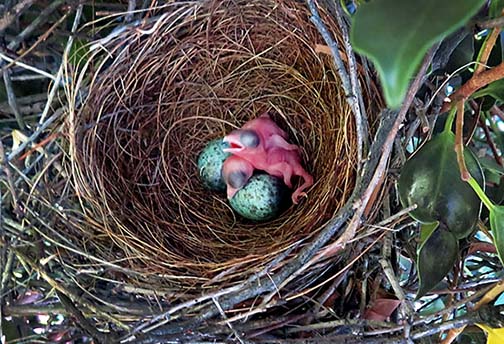Let’s head outdoors with Paul Faulstich

By Paul Faulstich
We missed the animals. Did they miss us?
With the reopening of the Claremont Hills Wilderness Park, we can once again venture out and hike in our celebrated chaparral. But what was happening behind locked gates, when the Park was closed to visitors? Paul Faulstich has some inkling. His on-going research in the CHWP caught some fantastic photos of undisturbed wildlife. Here are a few of his trailcam photos.
California scrub jay chicks are fed by both parents. The young leave the nest about 18-22 days after hatching, and the adults will protect and feed them for at least another month. These two chicks still have their egg tooth, the tiny horn-like projection at the tip of the upper beak, which will fall off soon. About three days before the chick hatches, it uses this egg tooth to break through the inner membrane to get at the air cell at the bunt end of the egg. This gives them the added oxygen they need, while allowing them to exercise their respiratory systems before using their egg teeth to punch through their shells.
Bobcat
Bobcats are mid-size predators, about twice the size of a housecat. They’re named for their tails, which appears to be cut or “bobbed.” Territories are established with scent markings and their size varies: generally, 25-30 square miles for males and about 5 square miles for females.
Bobcats can hunt prey much bigger than themselves, but they usually stick to birds, mice, squirrels, and other small game. Each bobcat may have several dens in its territory. Its main den is often a rock shelter, and auxiliary dens, scattered in less-visited areas, are brush piles or rock ledges. Faulstich lives adjacent to the Wilderness Park, and he and his neighbors have noticed that in the weeks since the shutdown is more bobcat activity than ever before.
Black Bear
Black bears are the largest animal inhabiting the San Gabriel Mountains. Despite their name, Black bears are brown. Indeed, they can range from chocolate to cinnamon to blonde. The population—estimated to be between 400 and 500 bears–are all descendants of 11 bears deported from Yosemite National Park in 1932 for being troublemakers. Black bears are rarely aggressive, and shy away from confrontations with people. Other than mating season, and when females are raising cubs, they’re usually solitary animals.
Grey Fox
The Grey fox is omnivorous, subsisting on seeds and berries, birds, insects, and rodents.
In our area they’re most active at night, though they can be out and about any time. They prefer rocky canyons and wooded areas, but are also found on the ridgelines and in the grasslands.
Coyote
Coyotes are surprisingly rare in the foothills, preferring the suburbs below. However, the coyotes in the protected hills are healthier than their suburban brothers and sisters. Many of the coyotes in our neighborhoods suffer from mange, symptoms of which include terrible itching, sores, and eventual death. Mange is related to the use of rat poison, and ironically these rodenticides kill the very animals that keep rat populations in check. Please avoid using these poisons.
Great Horned Owl
Female Great Horned owls are larger than their mates, but males have stronger and deeper voices. Pairs often call together, with audible differences in pitch. This powerful predator can take down birds and mammals larger than itself, but also dines on daintier fare like scorpions and mice. Great Horned owls are covered in super soft feathers that help them fly in silent pursuit of prey. Though their eyes don’t move in their sockets, owls can swivel their heads more than 180 degrees.
Mountain Lion
Mountain lions, also called cougars, pumas, and panthers, survive at low population densities. In southern California, the populations of mountain lions are isolated and at risk of inbreeding and local extinction. The size of their territories depends on terrain, vegetation, and abundance of prey, and in our area the territory for male lions is about 100 square miles. Cougars hunt species as small as rodents, even insects, but their primary food is deer. These big cats are shy and secretive, and are essentially no threat to humans.
Mule Deer
One of the most frequently seen animals in the Wilderness Park is the Mule deer. They have a 310-degree view, with excellent night vision, but less accurate daytime and color vision than humans. Deer can detect slight predator movement 600 meters away, yet aren’t good at discerning motionless forms beyond about 4 meters. Their primary diet is acorns in the fall, herbaceous plants in winter, and grasses in spring and summer. Surprisingly, there seems to have been less deer activity in recent weeks, perhaps because without people around the deer are in greater danger from predators, who generally steer clear of humans.











0 Comments